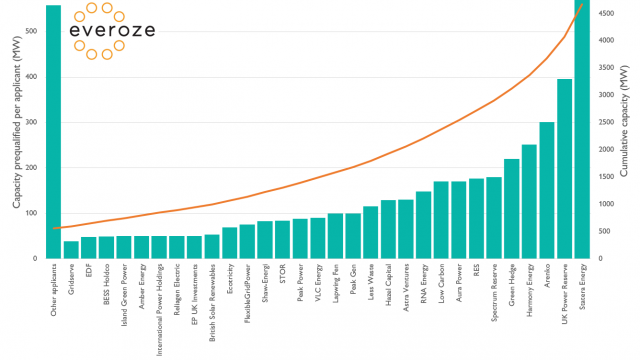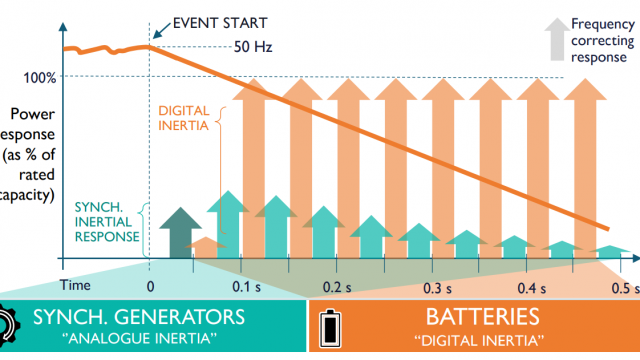Shock prices in UK Capacity Market drive Battery model 2.0
February 2018
The shock low prices in the UK T-4 Capacity Market of £8.40/kW/yr have spooked some. But necessity is the mother of invention: these prices are spurring a transition to Battery model 2.0, prompting some creative solutions.
Wow. £8.40/kW/yr. That’s where the T-4 Capacity Market cleared, and it’s pretty darn low. Great for consumers; not so great for anybody developing a battery project – particularly after de-rating last year and growing saturation in frequency response markets.
But there’s an old English proverb: necessity is the mother of invention. And it sums up perfectly what’s happening right now. Low Capacity Market prices don’t spell the death of an industry, but they do trigger an end to early business models – and the creation of something more exciting in its place. Let us explain…
The grand transition
At Everoze, we believe that something pretty fundamental is happening in the burgeoning battery sector: the transition from Battery model 1.0 to Battery model 2.0. This is based around three parameters, explained further below:
- Revenue stack complexity
- Revenue strategy
- Revenue risk.
1. Revenue stack complexity – it’s increasing
Battery model 1.0 was characterised by the classic revenue stack of 24/7 frequency response plus capacity market, accessed by utility-scale battery systems operated in a standalone fashion. This model itself is far from simple, with early pioneers having to battle with regulatory uncertainty and the nuances of Relevant Balancing Services regulation. But compared with what’s coming, it’s gonna seem pretty vanilla.
Because in Battery model 2.0, revenue complexity is sky-high. With National Grid reviewing exclusivity clauses in its contracts, and new revenues such as DSO servicespopping up, options are multiplying fast. Following Ofgem clarification on subsidies, co-location with renewables is now viable, again increasing options. And some of these new opportunities emerge from outside traditional spheres – including electric vehicle charging and other energy user services. Yep, Battery model 2.0 is pretty complex, and increasingly site-specific.
2. Revenue strategy – it’s all about agility
Under Battery model 1.0, investors sought to lock down as much revenue as possible – desperately trying to achieve revenue certainty of a level similar to what we’ve historically seen for renewables. This made longer-term contracts such as the Capacity Market (15 years) and Enhanced Frequency Response (4 years) particularly attractive.
But in Battery model 2.0, revenue strategy is turned on its head: the goal is typically not to lock down revenue stacks, but to prepare to revenue-hop. Pricing in different flexibility markets is dynamic, and National Grid’s new Product Roadmap will create new options for those who are agile, as it moves to closer to real-time procurement. Industry is seeking to maximise revenue options, with futureproofing and agility emerging as the new buzzwords. Of course, locked down revenues are preferred – but in Battery model 2.0, it’s no longer a firm requirement.
3. Bearer of revenue risk – it’s moving to private sector actors
Under Battery model 1.0, industry looked to System Operators and policymakers to provide revenue certainty, arguing for long-term contracts. In other words, industry sought to push revenue/cost risk onto consumers – and this was justified by the benefits of lower cost of capital, and appropriate to the technology’s state of maturity.
In Battery model 2.0, the bearer of risk is transitioning from the consumer to the private sector – closer to what we see in continental Europe. Innovative players are stepping in to take a view on the market, and offer a price floor over multi-year horizons. Let’s take aggregators as an example. With 20 registered aggregators in the UK market and margins under pressure, it’s not surprising that some are differentiating on product rather than caving in to a price war. One solution is for aggregators to accept greater market risk to create bankable contracts (notwithstanding counterparty risk), rather than merely offering battery developers a short-term route to market. Similar themes are seen amongst energy suppliers, PPA providers, utilities and leasing financiers.
This transition towards market players bearing more risk does not mean that system operators, regulators and policymakers are off the hook: far from it. They need to continue to remove barriers to entry; an obvious example is battery augmentation treatment in Capacity Market rules – Everoze is currently working with the Electricity Storage Network to help form recommendations on this topic. And critically these organisations need to adopt an investor mindset: creating a transparent and fair regime in which private sector actors can innovate.
Revenue revenue revenue
So – necessity is the mother of invention, and it’s giving birth to Battery model 2.0.
And at the heart of this creative disruption is revenue. Right from our early foray into batteries, Everoze’s philosophy was clear: with storage, you simply cannot separate the technical from the commercial. You cannot design a winning battery storage system without understanding what it needs to be able to do. You certainly can’t negotiate robust warranties until you know the range of plausible operating scenarios. Understanding the revenue context is fundamental – and we believe this applies more than ever under Battery model 2.0.
This transition won’t be easy. Like all of you, we’re battling to find repeatable, scaleable solutions for the storage market, to uncover efficiencies and standardised processes at a time when revenue stacks look increasingly bespoke. But necessity is the mother of invention. So, we’ll innovate, we’ll make it work.
And that, incidentally, applies whether the Capacity Market price is £8.40 or 84 pence.







